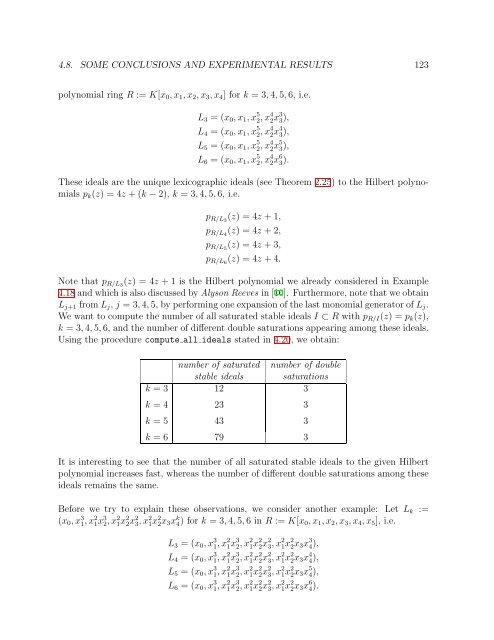122 CHAPTER 4. ALGORITHMS FOR STABLE IDEALSThe first list gives the values h R/Lp (i), 0 ≤ i ≤ 9, <strong>of</strong> the Hilbert function <strong>of</strong> R/L p for theunique lexicographic ideal L p associated to p(z). As we see now, the above values demonstratethe result presented in Corollary 3.40, where we characterized the ideal L p as theunique lexicographic ideal, such that the values <strong>of</strong> the Hilbert function h R/Lp are minimalamong the values <strong>of</strong> all Hilbert functions associated to p(z).Note that we have determined the first ten values <strong>of</strong> all Hilbert functions associatedto the Hilbert polynomial p(z) = 4z + 1 (the underlying polynomial ring is given byR := K[x 0 , x 1 , x 2 , x 3 , x 4 ]). This is the case, since in Example 4.24 we computed all Hilbertseries associated to p(z). Hence, there cannot be any other Hilbert function than those,whose first ten values are presented above.As this particular example shows, there also is a unique lexicographic ideal L H associatedto some Hilbert series H(t), such that p R/LH (z) = p(z) and the values <strong>of</strong> the Hilbertfunction h R/LH are maximal in each degree (compared to the values <strong>of</strong> all other Hilbertfunctions associated to p(z) in a fixed degree): The second line from below gives the firstten values <strong>of</strong> this Hilbert function. In each degree, the value <strong>of</strong> this Hilbert function isat least as large as the corresponding value <strong>of</strong> any other Hilbert function associated to p(z).In the last section <strong>of</strong> this chapter we state some interesting experimental results and conclusionsconcerning the “behaviour” <strong>of</strong> Algorithm 3.45 to compute all saturated stableideals to a given Hilbert polynomial p(z) and the effect <strong>of</strong> the structure <strong>of</strong> the uniquelexicographic ideal L p associated to p(z) by Theorem 2.25.4.8 Appendix: Some conclusions and experimentalresultsWithin the time, the algorithms have been implemented in MuPAD, several more exampleshave been computed. These examples could not be discussed in detail in the precedingsections, since this would have overstepped the framework <strong>of</strong> this thesis. Nevertheless,some <strong>of</strong> the examples, which were originally computed for checking the correctness <strong>of</strong> theimplementations presented here, provided some interesting results (most <strong>of</strong> the examplescan be found in the file “testfile.mu”, a special file for checking the MuPAD procedures<strong>of</strong> this chapter automatically, which is also contained on the CD in the appendix to thisthesis).It turned out that the “structure” <strong>of</strong> the unique lexicographic ideal L p associated to someHilbert polynomial p(z) (see Theorem 2.25) has a strong effect not only on the number <strong>of</strong>all saturated stable ideals I ⊂ K[x 0 , . . . , x n ] with p(z) = p R/I (z), but also on the number<strong>of</strong> different double saturations appearing among these ideals.As a first example, let us consider the four ideals defined by L k := (x 0 , x 1 , x 5 2, x 4 2x k 3) in the
4.8. SOME CONCLUSIONS AND EXPERIMENTAL RESULTS 123polynomial ring R := K[x 0 , x 1 , x 2 , x 3 , x 4 ] for k = 3, 4, 5, 6, i.e.L 3 = (x 0 , x 1 , x 5 2, x 4 2x 3 3),L 4 = (x 0 , x 1 , x 5 2, x 4 2x 4 3),L 5 = (x 0 , x 1 , x 5 2, x 4 2x 5 3),L 6 = (x 0 , x 1 , x 5 2, x 4 2x 6 3).These ideals are the unique lexicographic ideals (see Theorem 2.25) to the Hilbert polynomialsp k (z) = 4z + (k − 2), k = 3, 4, 5, 6, i.e.p R/L3 (z) = 4z + 1,p R/L4 (z) = 4z + 2,p R/L5 (z) = 4z + 3,p R/L6 (z) = 4z + 4.Note that p R/L3 (z) = 4z + 1 is the Hilbert polynomial we already considered in Example4.18 and which is also discussed by Alyson Reeves in [16]. Furthermore, note that we obtainL j+1 from L j , j = 3, 4, 5, by performing one expansion <strong>of</strong> the last monomial generator <strong>of</strong> L j .We want to compute the number <strong>of</strong> all saturated stable ideals I ⊂ R with p R/I (z) = p k (z),k = 3, 4, 5, 6, and the number <strong>of</strong> different double saturations appearing among these ideals.Using the procedure compute all ideals stated in 4.20, we obtain:number <strong>of</strong> saturated number <strong>of</strong> doublestable ideals saturationsk = 3 12 3k = 4 23 3k = 5 43 3k = 6 79 3It is interesting to see that the number <strong>of</strong> all saturated stable ideals to the given Hilbertpolynomial increases fast, whereas the number <strong>of</strong> different double saturations among theseideals remains the same.Before we try to explain these observations, we consider another example: Let L k :=(x 0 , x 3 1, x 2 1x 3 2, x 2 1x 2 2x 2 3, x 2 1x 2 2x 3 x k 4) for k = 3, 4, 5, 6 in R := K[x 0 , x 1 , x 2 , x 3 , x 4 , x 5 ], i.e.L 3 = (x 0 , x 3 1, x 2 1x 3 2, x 2 1x 2 2x 2 3, x 2 1x 2 2x 3 x 3 4),L 4 = (x 0 , x 3 1, x 2 1x 3 2, x 2 1x 2 2x 2 3, x 2 1x 2 2x 3 x 4 4),L 5 = (x 0 , x 3 1, x 2 1x 3 2, x 2 1x 2 2x 2 3, x 2 1x 2 2x 3 x 5 4),L 6 = (x 0 , x 3 1, x 2 1x 3 2, x 2 1x 2 2x 2 3, x 2 1x 2 2x 3 x 6 4).
















